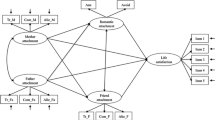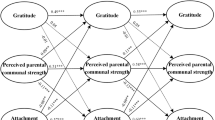Abstract
Parental attachment is associated with well-being in early emerging adulthood. The present study is the first to measure attachment from multiple perspectives by obtaining attachment ratings from both children and parents, allowing us to examine discrepancies between both attachments in the relationship and the association of those discrepancies with well-being. We used a large sample of 558 young emerging adults and 405 parents to assess self- and parent ratings of different facets of attachment and well-being. Using 15 structural equation models, we were able to show that security, trust, communication, and relatedness (but not dependency) are associated with the emerging adult’s subjective happiness, life satisfaction, and psychological flourishing. Moreover, psychological flourishing was higher for adult children whose parents were more attached to them than would be expected on basis of the child’s attachment.


Similar content being viewed by others
References
Ainsworth, M. D. (1989). Attachments beyond infancy. American Psychologist, 44(4), 709–716.
Armsden, G. C., & Greenberg, M. (1987). The inventory of parent and peer attachment: Individual differences and their relationship to psychological well-being in adolescence. Journal of Youth and Adolescence, 16(5), 427–454.
Arnett, J. J. (2000). Emerging adulthood. A theory of developement from the late teens through the twenties. American Psychologist, 55(5), 469–480. https://doi.org/10.1037/0003-066x.55.5.469.
Asendorpf, J. B., Banse, R., Wilpers, S., & Neyer, F. J. (1997). Beziehungsspezifische Bindungsskalen für Erwachsene und ihre Validierung durch Netzwerk- und Tagebuchverfahren [Relationship-specific attachment scales for adults and their validation with network and diary procedures]. Diagnostica, 43(4), 289–313.
Bartholomew, K., & Horowitz, L. M. (1991). Attachment styles among young adults: A test of a four-category model. Journal of Personality and Social Psychology, 61(2), 226–244.
Berman, W. H., & Sperling, M. B. (1991). Parental attachment and emotional distress in the transition to college. Journal of Youth and Adolescence, 20(4), 427–440.
Bowlby, J. (1969). Attachment and loss: Vol 1. Attachment. New York: Basic.
Bowlby, J. (1982). Attachment and loss: Vol. 3. Loss. New York: Basic.
Buhl, H. M. (2007). Well-being and the child–parent relationship at the transition from university to work life. Journal of Adolescence Research, 22(5), 550–571. https://doi.org/10.1177/0743558407305415.
Buhl, H. M. (2009). My mother: My best friend? Adults’ relationships with significant others across the lifespan. Journal of Adult Developement, 16, 239–249. https://doi.org/10.1007/s10804-009-9070-2.
Buhl, H. M., Wittmann, S., & Noack, P. (2003). Eltern-Kind-Beziehungen studierender und berufstätiger junger Erwachsener [Child–parent relationships of university students and working young adults]. Zeitschrift für Entwicklungspsychologie und Pädagogische Psychologie, 35, 144–152.
Campbell, D. T., & Fiske, D. W. (1959). Convergent and discriminant validation by the multitrait-multimethod matrix. Psycholoical Bulletin, 56(2), 81–105.
Caron, A., Lafontaine, M.-F., Bureau, J.-F., Levesque, C., & Johnson, S. M. (2012). Comparisions of close relationships: An evaluation of relationship quality and patterns of attachment to parents, friends, and romantic partners in young adults. Canadian Journal of Behavioral Science, 44(4), 245–256.
Connolly, J. J., Kavanagh, E. J., & Viswesvaran, C. (2007). The convergent validity between self and observer ratings of personality: A meta-analytic review. International Journal of Selection and Assessment, 15(1), 110–117.
Diener, E. (1984). Subjective well-being. Psychological Bulletin, 95(3), 542–575.
Diener, E., Emmons, R. A., Larsen, R. J., & Griffin, S. (1985). The Satisfaction with Life Scale. Journal of Personality Assessment, 49(1), 71–75.
Diener, E., Wirtz, D., Tov, W., Kim-Prieto, C., Choi, D.-W., Oishi, S., et al. (2010). New well-being measures: Short scales to assess flourishing and positive and negative feelings. Social Indicators Research, 97, 143–156. https://doi.org/10.1007/s11205-009-9493-y.
Eid, M. (2000). A multitrait-multimethod model with minimal assumptions. Psychometrika, 65(2), 241–261.
Eid, M., Geiser, C., & Koch, T. (2016). Measuring method effects: From traditional to design-oriented approaches. Current Directions in Psychological Science, 25(4), 275–280. https://doi.org/10.1177/0963721416649624.
Eid, M., Lischetzke, T., Nussbeck, F., & Trierweiler, L. (2003). Separating trait effects from trait-specific method effects in multitrait-multimethod models: A multiple-indicator CT-C(M-1) model. Psychological Methods, 8(1), 38–60.
Eid, M., Nussbeck, F. W., Geiser, C., Cole, D. A., Gollwitzer, M., & Lischetzke, T. (2008). Structural equation modeling of multitrait-multimethod data: Different models for different types of methods. Psychological Methods, 13(3), 230–253.
Fleming, A. S. (2005). Plasticity on innate behavior: Experiences throughout life affect maternal behavior and its neurobiology. In C. S. Carter, L. Ahnert, K. E. Grossmann, S. B. Hrdy, M. E. Lamb, S. W. Porges, & N. Sachser (Eds.), Attachment and bonding (pp. 137–168). Cambrigde: MIT Press.
Fraley, R. C., Hudson, N. W., Heffernan, M. E., & Segal, N. (2015). Are adult attachment styles categorical or dimensional? A taxometric analysis of general and relationship-specific attachment orientations. Journal of Personality and Social Psychology, 109(2), 354–368. https://doi.org/10.1037/pspp0000027.
Fraley, R. C., & Shaver, P. R. (2000). Adult romantic attachment: Theoretical developments, emerging controversies, and unanswered questions. Review of General Psychology, 4, 132–154.
Furmann, W., Simon, V. A., Shaffer, L., & Bouchey, H. A. (2002). Adolescents’ working model and styles for relationships with parents, friends, and romantic partners. Child Developement, 73(1), 241–255.
Glaesmer, H., Grande, G., Braehler, E., & Roth, M. (2011). The German version of the Satisfaction with Life Scale (SWLS). European Journal of Psychological Assessment, 27(2), 127–132.
Golish, T. D. (2000). Changes in closeness between adult children and their parents: A turning point analysis. Communication Reports, 13(2), 79–97.
Haggerty, G., Siefert, C., Bornstein, R. F., Sinclair, S. J., Blais, M. A., Zodan, J., et al. (2015). Correlates of interpersonal dependency and detachment in an adolescent inpatient sample. Bulletin of the Menninger Clinic, 79(4), 281–304. https://doi.org/10.1521/bumc.2015.79.4.281.
Hazan, C., & Shaver, P. (1987). Romantic love conceptualized as an attachment process. Journal of Personality and Social Psychology, 52(3), 511–524.
Hiester, M., Nordstrom, A., & Swenson, L. M. (2009). Stability and change in parental attachment and adjustment outcomes during the first semester transition to college life. Journal of College Student Development, 50(5), 521–538.
Hultell, D., & Gustavsson, J. P. (2008). A psychometric evaluation of the Satisfaction with Life Scale in a Swedish nationwide sample of university students. Personality and Individual Differences, 44, 1070–1079. https://doi.org/10.1016/j.paid.2007.10.030.
Jonkmann, K., Thoemmes, F., Lüdtke, O., & Trautwein, U. (2014). Personality traits and living arrangements in young adulthood: Selection and socialization. Developmental Psychology, 50(3), 683–698.
Karreman, A., & Vingerhoets, A. J. (2012). Attachment and well-being: The mediating role of emotion regulation and resilience. Personality and Individual Differences, 53, 821–826. https://doi.org/10.1016/j.paid.2012.06.014.
Koch, T., Holtmann, J., Bohn, J., & Eid, M. (2018). Explaining general and specific factors in longitudinal, multimethod, and bifactor models: Some caveats and recommendations. Psychological Methods. https://doi.org/10.1037/met0000146.
La Guardia, J. G., Ryan, R. M., Couchman, C. E., & Deci, E. L. (2000). Within-person variantion in security of attachment: A self-determination theory perspective on attachment, need fulfillment, and well-being. Journal of Personality and Social Psychology, 79(3), 367–384. https://doi.org/10.1037//0022-3514.79.3.367.
Larsen, R. J., & Eid, M. (2008). Ed Diener and the science of subjective well-being. In M. Eid & R. J. Larsen (Eds.), The science of subjective well-being (pp. 1–13). New York: The Guilford Press.
Lefkowitz, E. S. (2005). Things have gotten better: Developmental changes among emerging adults after the transition to university. Journal of Adolescent Research, 20(1), 40–63.
Levin, K. A., Dallago, L., & Currie, C. (2012). The association between adolescent life satisfaction, family structure, family affluence, and gender differences in parent-child communication. Social Indicators Research, 106(2), 287–305. https://doi.org/10.1007/s11205-011-9804-y.
Little, T. D., Cunningham, W. A., Shahar, G., & Widaman, K. F. (2002). To parcel or not to parcel: Exploring the question, weighing the merits. Structural Equation Modeling, 9(2), 151–173. https://doi.org/10.1207/S15328007SEM0902_1.
Little, T. D., Rhemtulla, M., Gibson, K., & Schoemann, A. M. (2013). Why the items versus parcels controversy needn’t be one. Psychological Methods, 18(3), 285–300. https://doi.org/10.1037/a0033266.
Luhmann, M., Bohn, J., Holtmann, J., Koch, T., & Eid, M. (2016). I’m lonely, can’t you tell? Convergent validity of self- and informant ratings of loneliness. Journal of Research in Personality, 61, 50–60.
Lyubomirsky, S., & Lepper, H. S. (1999). A measure of subjective happiness: Preliminary reliability and construct validation. Social Indicators Research, 46, 137–155.
Ma, C. Q., & Huebner, E. S. (2008). Attachment relationships and adolescents’ life satisfaction: Some relationships matter more to girls than boys. Psychology in the School, 45(2), 177–190. https://doi.org/10.1002/pits.20288.
McDonald, R. P. (1970). The theoretical foundations of principal factor analysis, canonical factor analysis, and alpha factor analysis. The British Journal of Mathematical and Statistical Psychology, 23(1), 1–21. https://doi.org/10.1111/j.2044-8317.1970.tb00432.x.
Mehl, M. R., Vazire, S., Holleran, S. E., & Clark, C. S. (2010). Eavesdropping on happiness: Well-being is related to having less small talk and more substantive conversations. Psychological Science, 21(4), 539–541. https://doi.org/10.1177/0956797610362675.
Mikulincer, M., & Shaver, P. R. (2013). Adult attachment and happiness: Individual differences in the experience and consequences of positive emotions. In S. A. David, I. Boniwell, & A. Conley Ayers (Eds.), Oxford handbook of happiness (pp. 834–846). New York: Oxford University Press.
Mikulincer, M., & Shaver, P. R. (2016). Attachment in adulthood (2nd ed.). New York: Guilford Press.
Mongrain, M., Komeylian, Z., & Barnhart, R. (2016). Happiness vs. mindfulness exercises for individuals vulnerable to depression. The Journal of Positive Psychology, 11(4), 366–377. https://doi.org/10.1080/17439760.2015.1092569.
Muthén, L. K., & Muthén, B. O. (1998–2015). Mplus user’s guide (Vol. 7). Los Angeles, CA: Muthén & Muthén.
Neumann, E. (2002). Von der Eltern-Kind-Bindung zur Paarbindung Erwachsener. Inaugural-Dissertation [From parent–child bonding to couple bonding in adulthood]. Bochum: Ruhr-Universität.
Nickerson, A. B., & Nagle, R. J. (2004). The influence of parent and peer attachments on life satisfaction in middle childhood and early adolescence. Social Indicator Research, 66, 35–60.
Peris, T. S., Goeke-Morey, M. C., Cummings, E. M., & Emery, R. E. (2008). Marital conflict and support seeking by parents in adolescence: Empirical support for the parentification construct. Journal of Family Psychology, 22(3), 633–642.
Ross, L. R., & Spinner, B. (2001). General and specific attachment representations in adulthood: Is there a relationship? Journal of Social and Personal Relationships, 18(6), 747–766.
Ryan, R. M., & Deci, E. L. (2001). On happiness and human potentials: A review of research on hedonic and eudaimonic well-being. Annual Review of Psychology, 52, 141–166.
Schermelleh-Engel, K., Moosbrugger, H., & Müller, H. (2003). Evaluating the fit of structural equation models: Tests of significance and descriptive goodness-of-fit measures. Methods of Psychological Research Online, 8(2), 23–74.
Schneider, L., & Schimmack, U. (2009). Self-informant agreement in well-being ratings: A meta-analysis. Social Indicators Research, 94, 363–376. https://doi.org/10.1007/s11205-009-9440-y.
Swami, V., Stieger, S., Voracek, M., Dressler, S. G., Eisma, L., & Furnham, A. (2009). Psychometric evaluation of the Tagalog and German subjective happiness scales and a cross-cultural comparision. Social Indicator Research, 93, 93–406. https://doi.org/10.1007/s11205-008-9331-7.
Tov, W. (2018). Well-being concepts and components. In E. Diener, S. Oishi, & L. Tay (Eds.), Handbook of well-being. Salt Lake City, UT: DEF Publishers.
Vassar, M. (2008). A note on the score reliability for the satisfaction with life scale: An RG study. Social Indicator Research, 86, 47–57. https://doi.org/10.1007/s11205-007-9113-7.
Wilkinson, R. B. (2004). The role of parental and peer attachment in the psychological health and self-esteem of adolescents. Journal of Youth and Adolescence, 33(6), 479–493.
Acknowldgements
We are grateful to Jana Stein and Caterina Betz for their assistance in data collection and Esther Ulitzsch for creating graphs and providing valuable feedback on an earlier draft. We also thank Lisa Trierweiler for her writing support.
Funding
The study was founded by Deutsche Forschungsgemeinschaft (Grand Number EI379/6-2) to Prof. Michael Eid.
Author information
Authors and Affiliations
Corresponding author
Ethics declarations
Conflict of interest
The authors declare that there is no conflict of interest regarding this study.
Ethical Approval
All procedures performed in this study were in accordance with the ethical standards of the ethics committee of the Freie Universität Berlin (date of the evaluation: 13.06.2013) and with the 1964 Helsinki declaration and its later amendments or comparable ethical standards. Informed consent was obtained from all individual participants included in the study.
Additional information
Publisher's Note
Springer Nature remains neutral with regard to jurisdictional claims in published maps and institutional affiliations.
Electronic supplementary material
Below is the link to the electronic supplementary material.
Rights and permissions
About this article
Cite this article
Bohn, J., Holtmann, J., Luhmann, M. et al. Attachment to Parents and Well-Being After High School Graduation: A Study Using Self- and Parent Ratings. J Happiness Stud 21, 2493–2525 (2020). https://doi.org/10.1007/s10902-019-00190-y
Published:
Issue Date:
DOI: https://doi.org/10.1007/s10902-019-00190-y




